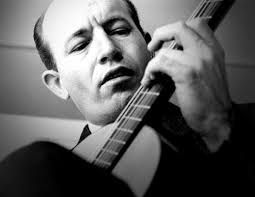

Triste means Sad and on Samba Triste the principals create a profound feeling of melancholy that never descends into pathos. To be fair to the guitarist his solos elsewhere have a melodic charm perfectly in keeping with the idiom. Charlie Byrd sounds uncomfortable here but Stan rescues the situation with a brisk, authoritative statement. On Desafinado the group seem to have decided on a montuno for the blowing choruses instead of using Jobim’s intriguing modulations. Getz would have been familiar with the 1945 Bing Crosby hit Baia, but the rest of this material was quite new to him. Even Coleman Hawkins dipped his toe into the water and when it eventually came to Paul Desmond’s turn in 1964 he wittily decided to call his effort Bossa Antigua or Old Thing. Bossa nova became known as the New Thing and Ted Gioia in his Jazz Standards says “After Getz’s success almost every member of Local 802 jumped on the bossa nova bandwagon”. They were familiar with the samba so that was how the recording was marketed and Jazz Samba eventually reached number 1 on the Billboard pop charts. Producer Creed Taylor apparently decided that “an American audience wouldn’t know what a bossa nova is”. And thus it is possible to understand why the beauty of the album will always remain eternal.This was the album that began the public’s love affair with the seductive rhythms and harmonies of the bossa nova although that term was not mentioned in the original sleeve-note. It is impossible to find a wrong note or an ill-advised motif anywhere on this album. This can be heard in “Samba Triste” and elsewhere. Finally there is music that captures the elemental longing of Brasilian longing. “O Pato,” “E Luxo Só” and “Bahia” are dreamlike and exemplify this. Getz loses himself in splendid labyrinthine melodies. Then there are the enchanted charts where Mr. And the music is played with impish wit, with the musicians even playfully naming a song such as “Samba Dees Days.” But the puckishness is never separated from the sublime and venerable nature of the melodies. The gentle reminder that most of the rest of the other charts are devolutions of folk music comes almost immediately after “Desafinado”. The ebullient explosion of the tenor after a bass and drum interlude forces the chart into overdrive before returning to its lulling rhythm. Listen to the opening bars of “Desafinado” and to its mid-section after Stan Getz is retreating from his solo and be amazed at the grace and passionate embrace of guitar and tenor saxophone. Getz’s tender saxophone, he holds back and retreats into a hypnotic rhythm that bobs and weaves in harmony with the rocketing melody. And just when it seems that he and his guitar would overcome Mr.

Getz’s motives, following the chordal inversions as a leonine hunter would track its prey. His attack is gentle almost stealthily so. His chords are slanted, gliding off the strings with deft fingering and making elliptical shapes around the notes that Mr. Although he plays a completely different instrument-whose persuasions are marked by dramatically different timbres-he somehow manages to become a doppelgänger of the tenor saxophonist. Charlie Byrd is also a big part of the magnificence of this album. It is therefore de rigueur to hang on to every note, every glorious phrase and the lilt of each and every magnificent line played by Stan Getz. Jazz Samba is tantalisingly short almost painfully so. On this and a handful of other albums he never disappointed. This was a rare privilege accorded only to Brasilians and to Mr. Getz joined Joao Gilberto, Vinicius de Moraes and Antonio Carlos Jobim and a clutch of legendary musicians from Brasil in becoming instrumental in spreading the Bossa Nova gospel. So it ought never to be a surprise that Mr. It seemed that the saxophonist had a magical feel for the rhythms of Samba and Bossa Nova the tantalizing backbeat that captivated continents and mesmerized a generation of musicians and dancers. Getz’s seemed to have been born with the God-given grace to negotiate complex and beguiling rhythms. Then it was his ability to hang the notes he played in curved air so they would resonate, linger and captivate the soul. First of all the tenor saxophonist seemingly developed his haunting, ethereal tone just so he could negotiate this music. Stan Getz is on it, leading a small ensemble on what is easily one of the finest recordings in this ineffable Brasilian idiom. There is a very good reason for the extraordinary longevity of this album years after Samba and Bossa Nova was invented by Brasilians. The year 2014 marks fifty-two years after the classic album Jazz Samba, was recorded.


 0 kommentar(er)
0 kommentar(er)
